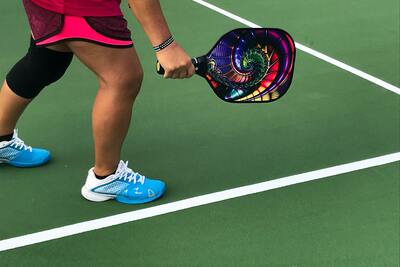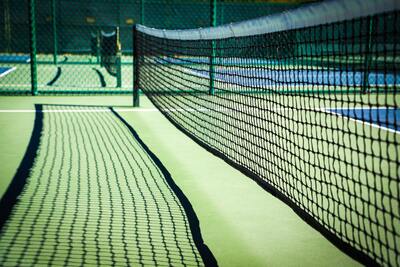Pickleball is one of the fastest growing sports globally, so it's come as no surprise that our Athlete Support Team have heard from an increasing number of pickleball players who want to learn how to nail their hydration and fueling strategies...
What is pickleball?
Whilst many of you reading this piece will be well aware of the ‘ins and outs’ of pickleball, it’s worth providing a little context for those who may be new to the game or contemplating picking up a paddle.
Pickleball is an energetic, racket/paddle sport based on a combination of badminton, tennis and table tennis. Played on a badminton-size court, it’s fast paced, with rallies taking place close to the net.
Typical pickleball matches tend to last around 60-90 minutes, but it’s the intense nature of the sport coupled with generally being played indoors or in hot and humid conditions that makes staying well fueled and hydrated a challenge. This is especially true in tournament play, where you might play multiple matches in a day or across the weekend.
Negating the cumulative effects of carbohydrate, fluid and sodium losses across a number of matches will help to give you the edge later on in the tournament.
https://www.youtube.com/watch?v=kqLRRNOpe8U
How to personalize your hydration strategy for pickleball
With over a decade of Sweat Testing experience, we’ve seen that there's a huge variance in the amount of sodium individuals lose in their sweat (from ~200mg/L in some athletes to over 2,000mg/L in others). This means that a ‘one-size-fits-all’ approach to hydration on the pickleball court may not be sufficient, especially if optimal performance is the goal.
The physical nature of pickleball means it’s crucial to maintain hydration levels. The body is under considerable stress during exercise in order to provide the working muscles with oxygen and regulate core body temperature. Dehydration will increase the strain the body is put under to meet this demand.
It’s important to remember that the environmental conditions will also play a part in the overall hydration requirements. Often pickleball is played in the hotter months of the year (or indoors), meaning that sweat losses are likely to be greater.
The variations in sweat rate (i.e. how much fluid you lose) and sweat sodium concentration (i.e. how salty your sweat is) between players means that the net sweat sodium losses that you and your opponent experience on the court can be vastly different. Subsequently, players' hydration strategies should reflect this individuality.
To understand your personal sweat sodium losses, take our free Online Sweat Test or book in for an Advanced Sweat Test at one of our Sweat Test Centers. Then collect some sweat rate data to refine your strategy further.
How to START your pickleball match hydrated
Firstly, it's imperative that you're heading into your match in a hydrated state. This is often where athletes let themselves down. A recent study has shown that 31% of athletes (over 400 amateur athletes) were turning up to training and competition dehydrated.
You can help to avoid this, and ensure that you’re starting your matches optimally hydrated by consuming a strong electrolyte drink like PH 1500. We call this ‘preloading’ and the recommended protocol looks like this:
- Drink 1 x PH 1500 tablet or packet with ~16oz (~500ml) of water the night before a match
- Drink 1 x PH 1500 tablet or packet with ~16oz (~500ml) of water about 90 mins before you walk on to the court
This process will help to maximize your blood plasma volume, giving you greater reserves of fluids and electrolytes to draw from ahead of your match.
How to stay hydrated on the court
Make sure that you have access to enough fluid and electrolytes for your longest possible match or, in tournament play, enough for all of the matches that you may end up playing.

You should listen to your body and predominantly drink to thirst. This is the mechanism your body has evolved to tell you what it needs. Don’t wait until it is too late as it’s not always clear how long a match will last. With the limited opportunities that are presented to you in order to rehydrate, it's important that you take advantage of those moments to replenish your fluid and electrolytes. Utilise the change of ends and breaks in play where drinking may be possible to ensure adequate replacement.
You need to replace some of the electrolytes you lose in your sweat too. And, by ‘electrolytes’, we generally mean sodium, as that’s the electrolyte you lose the most of in your sweat - potassium, calcium and magnesium losses are generally small in comparison. Sodium is also the most important electrolyte when it comes to fluid balance in the body.
If you only drink water over an extended period of exercise where you’re sweating, you’re potentially further diluting your blood sodium levels and are at risk of giving yourself a condition called hyponatremia (literally meaning ‘low blood sodium levels’) which can have some nasty side effects.
Rehydrate and recover after your match
The likelihood is that you will finish most of your matches dehydrated, to some extent. If your sweat losses have been low, the food and drinks you consume after your match should provide sufficient replenishment in order to bring your fluid and electrolytes back into line.
However, if you’re in tournament play and you have multiple matches in a day or across a few days, a more aggressive approach to rehydration and recovery may be needed to help restore your body’s fluid and electrolyte balance.
In these instances, taking in electrolytes with your post-match fluids will help fluid retention, so try drinking 1 x PH 1500 mixed with ~16oz (~500ml) of water within 45 minutes of finishing your match.
A fueling strategy for pickleball
Given the nature of pickleball, you’ll be burning calories (mainly in the form of carbohydrates) during play. With that in mind, arriving at your match well fueled is vital for performance. Consider consuming a meal with a high proportion of carbohydrates (1-4 grams of carb per kilo of body weight) in the 1-4 hours prior to your match/tournament. This should ensure you have sufficient glycogen stores for what is to come.

Matches typically aren’t long enough for you to run these stores dry, but it would be worthwhile having some carb-rich fuel sources available. Having something like an energy gel or sports bar in your bag may be a great option. You can then choose to reach for one of these mid-match should you go beyond the 60-minute mark.
If you’re playing a tournament, having some carb rich snacks with you to consume between matches will allow you to replenish your glycogen stores ahead of the next round. This will aid recovery and ensure you're not heading into the latter stages of the tournament depleted.
If you follow these steps and continue to refine your fueling and hydration strategy in training and competition, you'll have the tools in your kitbag to perform at your best on the court.
Of course, if you have any questions about your strategy for pickleball, you can book a free one-to-one video call or dink us an email on hello@pfandh.com.
